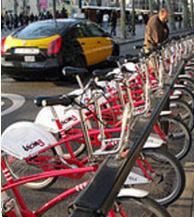Bicing is a public cycle hire network that is integrated into and complements the existing public transport of network of buses, metro, tram and train. Barcelona is a city with a dense urban population and high level of pedestrians. Bicing has a triple effect – it encourages users not to drive; it promotes intermodal travel; and, at key times, it relieves congestion on the existing public transport infrastructure. The overall increase in capacity means a reduction in use of private automobiles, improved local air quality and a reduction in greenhouse gas emissions.
How does it work?
Bicing offers a network of 1500 cycles, stationed at 100 points around the city, that are available for hire 24 hours a day on Fridays and Saturdays and from 5am to midnight on other days. Users can move around the city, leaving the cycle at other stations and changing between cycles to maximize low-cost travel (each “hire” has a 30-minute period low-cost use, after which charges rise). Bicing stations are located close to stations for metro, train or light rail, close to public parks or green spaces, and within 300 metres of another Bicing station, meaning the system is accessible and well-connected to other transport modes.
The city has reinforced the potential of the scheme by undertaking a range of initiatives to make cycling easier. 7000 new cycle stations are being constructed, adding to existing infrastructure and creating close to 15,000 stations around the city. 30 km/hour speed limits for automobiles have been established in different parts of the city and 22 km of new cycle lanes will be added to the city’s existing 128 km network.
Results
In the first six months of Bicing, over 90,000 people subscribed to the service. In total, 2 million hires covering over 6 million km of travel were made. The typical uses are students or office workers aged 25-35, living in the central Eixample and Gracia districts – 51% of subscribers are aged 25-35 and there is a 50-50 split between men and women as a proportion of the total subscribers. 57% of users make their journey for work reasons.
During the week, around 100,000 hires occur, with 30,000 at weekends and holidays. Each cycle is hired an average 15 times per day and each station registers an average 270 hires per day. A typical user hires an average 1.4 cycles per weekday and 1.1 cycles per day on weekends/holidays. A typical journey lasts between 17-20 minutes and covers 3km. 71.63% of users exclusively use Bicing for their travel whilst 28.37% of users combine Bicing with other modes of transport.
Of these users, 33.87% combine Bicing with metro; 21.85% with train; 13.45% with light rail; 9.47% with bus; 8.25% with walking; 4.32% with tram; 4.03% with intercity buses; 3.24% with car (driving); 0.98% with car (passenger); 0.29% with motorcycle; 0.25% with personal cycle. Combining with private car either as passenger or driver represents only 4.22% of this total, but it should be pointed out that this only accounts for users combining Bicing with other modes of transport – and that 71.63% of users exclusively use Bicing!
CO2 emissions reductions
Barcelona estimates that 960 tonnes of CO2 were avoided during the first six months of Bicing operations. However, as the service has expanded incrementally during this period, this number is likely to increase over a full 12-month period operating at full capacity.
Costs
The implementation of Bicing was financed by incomes from the regulation of parking in the city – ie. penalties, parking fees, etc. The service is operated by Clear Channel on a ten-year service contract valued at €22.3 million.
Next steps
In spring 2008, Bicing will be extended to offer 6000 cycles at 400 stations.



